A Novel Experimental Investigation of Cement Mechanical Properties with Application to Geothermal Wells
Abstract
:1. Introduction
2. Experimental Approach
2.1. Sample Preparation
2.2. Experimental Setup
- Fmax is the maximum recorded force, N;
- IDB is the inner diameter of the shoulder, m;
- SL is the shear length of cement in the cell, m.
- Fmax is the maximum recorded force, N;
- IDA is the inner diameter of the cell, m;
- CL is the interfacial bonding shear strength cell length, m.
2.3. Elevated Curing Temperature Experiments and Results
3. Discussions
4. Conclusions
- Pure shear strength for specimens cured at elevated temperature is higher than that for specimens cured for the same days at room temperature, which was expected.
- The value of interfacial bonding shear strength for specimens cured at elevated temperature is lower than the one obtained in room temperature conditions and it does not increase as strongly as we observed for room temperature conditions. This observation is new and has never been published.
- The measured pure shear strength for specimens cured at elevated temperature was 17.1 MPa which is 2.1 times greater than it was at room temperature for day 3. After 14 days, a decrease of the pure shear strength occurs, although the UCS was minimally increasing.
Author Contributions
Funding
Acknowledgments
Conflicts of Interest
Nomenclature
| Area, m2 | |
| Correction coefficient for Hashin-Shtrikman 3-phase boundaries | |
| Thermal conductivity, W/m-K or BTU/hr-ft-°F | |
| Thickness, m | |
| Amount of heat transferred through material, W | |
| Temperature gradient, K | |
| Water fraction inside the pores, - | |
| Component mass fraction, - | |
| Cement porosity, - |
References
- Kömürcü, M.İ.; Akpınar, A. Importance of geothermal energy and its environmental effects in Turkey. Renew. Energy 2009, 34, 1611–1615. [Google Scholar]
- Alber, M.; Ehringhausen, N. Petrophysical properties of casing cement while curing. Int. Soc. Rock Mech. Rock Eng. 2017, 191, 164–171. [Google Scholar] [CrossRef]
- Wehling, P. Wellbore Cement Integrity Testing. Master’s Thesis, TU-Clausthal, Clausthal-Zellerfeld, Germany, 2008. [Google Scholar]
- Nelson, E.B. Well Cementing; Elsevier: Amsterdam, The Netherlands, 1990. [Google Scholar]
- Teodoriu, C.; Ichim, A.C.; Falcone, G. Design optimization of geothermal wells using an improved overall heat transfer coefficient. In Proceedings of the 42nd Stanford Geothermal Workshop, Stanford, CA, USA, 13–14 February 2017. [Google Scholar]
- Ichim, A.C.; Teodoriu, C. Revisiting thermal well integrity through a closer look at casing-cement-formation interaction. In Proceedings of the SPE Thermal Well Integrity and Design Symposium, Banff, AB, Canada, 28 November–1 December 2016. [Google Scholar]
- Philippacopoulos, J.A.; Berndt, L.M. Structural analysis of geothermal well cements. Geothermics 2002, 31, 657–676. [Google Scholar] [CrossRef]
- Teodoriu, C. Why and When Does Casing Fail in Geothermal Wells: A Surprising Question? In Proceedings of the World Geothermal Congress 2015, Melbourne, Australia, 19–25 April 2015. [Google Scholar]
- Ichim, A.C.; Teodoriu, C. Development of a cement repository to improve the understanding of well integrity behavior with time. In Proceedings of the SPE Oklahoma City Oil and Gas Symposium, Oklahoma City, OK, USA, 27–31 March 2017. [Google Scholar]
- Wong, R.C.K.; Ma, S.K.Y.; Wong, R.H.C.; Chau, K.T. Shear strength components of concrete under direct shearing. Cem. Concr. Res. 2007, 37, 1248–1256. [Google Scholar] [CrossRef]
- Bejar, L.A.; Rushing, T.S. Computational Shear Strength of Ultrahigh-Performance API Class H Cement-Silica-Fume Paste Cylinders via Direct Shear Tests. J. Mater. Civ. Eng. 2017, 29, 04017113. [Google Scholar] [CrossRef]
- Evans, G.W.; Carter, L.G. Bonding Studies of Cementing Compositions to Pipe and Formations; American Petroleum Institute: Washington, DC, USA, 1962. [Google Scholar]
- Zhao, X.; Guan, Z.; Xu, M.; Shi, Y.; Liao, H.; Sun, J. The Influence of casing-sand adhesion on cementing bond strength. PLoS ONE 2015, 10, e0130892. [Google Scholar] [CrossRef]
- Salehi, S.; Khattak, M.J.; Ali, N. Development of geopolymer-based cement slurries with enhanced thickening time, compressive and shear bond strength and durability. In Proceedings of the IADC/SPE Drilling Conference and Exhibition, Fort Worth, TX, USA, 1–3 March 2016. [Google Scholar]
- Lavrov, A.; Torsæter, M. Physics and Mechanics of Primary Well Cementing; Springer: Berlin, Germany, 2016. [Google Scholar]
- Kaldal, G.S.; Jónsson, M.; Pálsson, H.; Karlsdóttir, S.N. Structural Analysis of casings in high temperature geothermal wells in Iceland. In Proceedings of the World Geothermal Congress, Melbourne, Australia, 19–25 April 2015. [Google Scholar]
- API (American Petroleum Institute). Specification for Cements and Materials for Well Cementing; American Petroleum Institute: Washington, DC, USA, 2002. [Google Scholar]
- API (American Petroleum Institute). Recommended Practice for Testing Well Cements; American Petroleum Institute: Washington, DC, USA, 2013. [Google Scholar]
- Romanowski, N.; Ichim, A.C.; Teodoriu, C. Investigations on oilwell cement strength response to ultrasonic measurements in the presence of additives. J. Energy Res. Technol. 2018, 140, 072904. [Google Scholar] [CrossRef]
- Saleh, F.K.; Salehi, S.; Teodoriu, C. Experimental investigation of mixing energy of well cements: The gap between laboratory and field mixing. J. Nat. Gas Sci. Eng. 2019, 63, 47–57. [Google Scholar] [CrossRef]
- Won, J.; Lee, D.; Na, K.; Lee, I.M.; Choi, H. Physical properties of G-class cement for geothermal well cementing in South Korea. Renev. Energy 2015, 80, 123–131. [Google Scholar] [CrossRef]
- Miranda, C.R.; Toledo Filho, R.D.; Fairbairn, E.M.R.; Thaumaturgo, C.; Vargas, A.A.; Oliveira, G.M.B.; Teixeira, K.C. New design of high-performance cement systems for zonal isolation: influence of porosity, rheological parameters and chemical and mechanical resistance. In Proceedings of the SPE Latin American and Caribbean Petroleum Engineering Conference, Lima, Peru, 1–3 December 2010. [Google Scholar]
- Jimenez, W.C.; Pang, X.; Urdaneta, J.A.; Sørensen, E.; Lende, G.; Nimane, S. Thermo-mechanical properties of annular sealants—A path to optimized wellbore integrity and economics. In Proceedings of the SPE Kuwait Oil & Gas Show and Conference, Kuwait City, Kuwait, 15–18 October 2017. [Google Scholar]
- Bwala, A.H. Experimental Investigation of Shear Bond Strength and Microstructure of Fly Ash Geopolymer Cement for Oil and Gas Industry. Master’s Thesis, University of Louisiana at Lafayette, Lafayette, LA, USA, August 2015. [Google Scholar]
- Teodoriu, C.; Yi, M.C.; Ichim, A.C.; Salehi, S. A novel view of cement failure with application to geothermal well construction. In Proceedings of the 43rd Workshop on Geothermal Reservoir Engineering, Stanford, CA, USA, 12–14 February 2018. [Google Scholar]
- Teodoriu, C.; Kosinowski, C. Wellbore integrity and cement failure at HPHT conditions. Int. J. Eng. App. Sci. 2013, 2, 2305–8269. [Google Scholar]
- Kosinowski, C.; Teodoriu, C. Study of class G cement fatigue using experimental investigations. In Proceedings of the SPE/EAGE European Unconventional Resources Conference & Exhibition–From Potential to Production, Vienna, Austria, 19–22 March 2012. [Google Scholar]


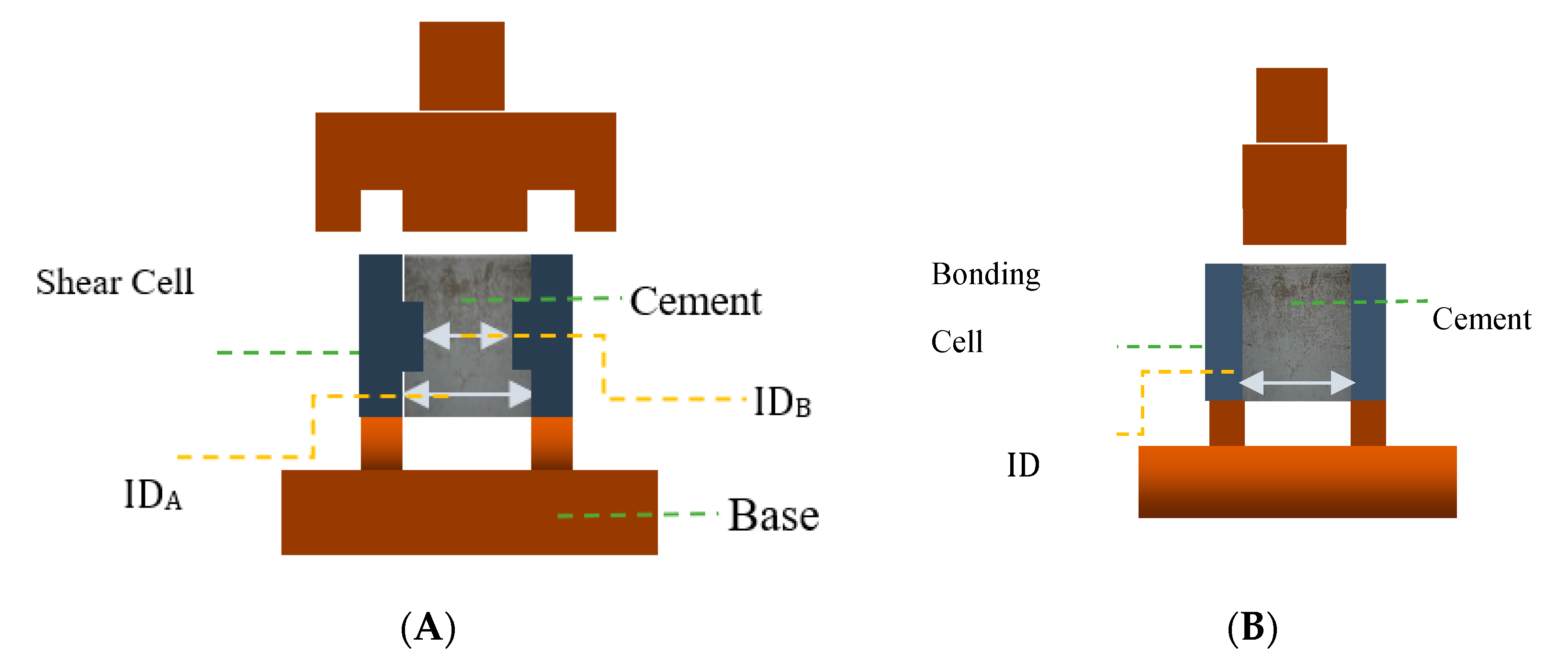
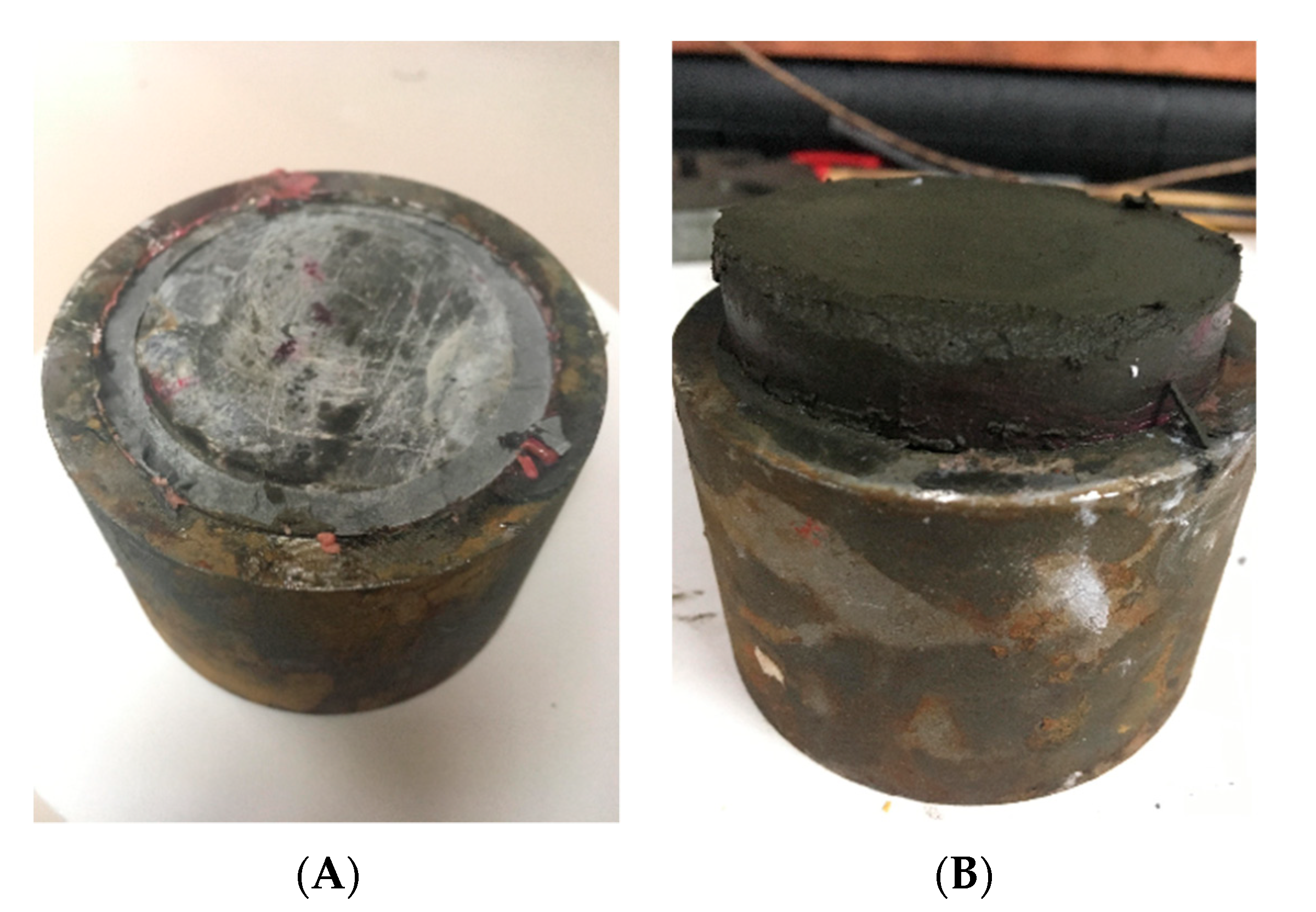
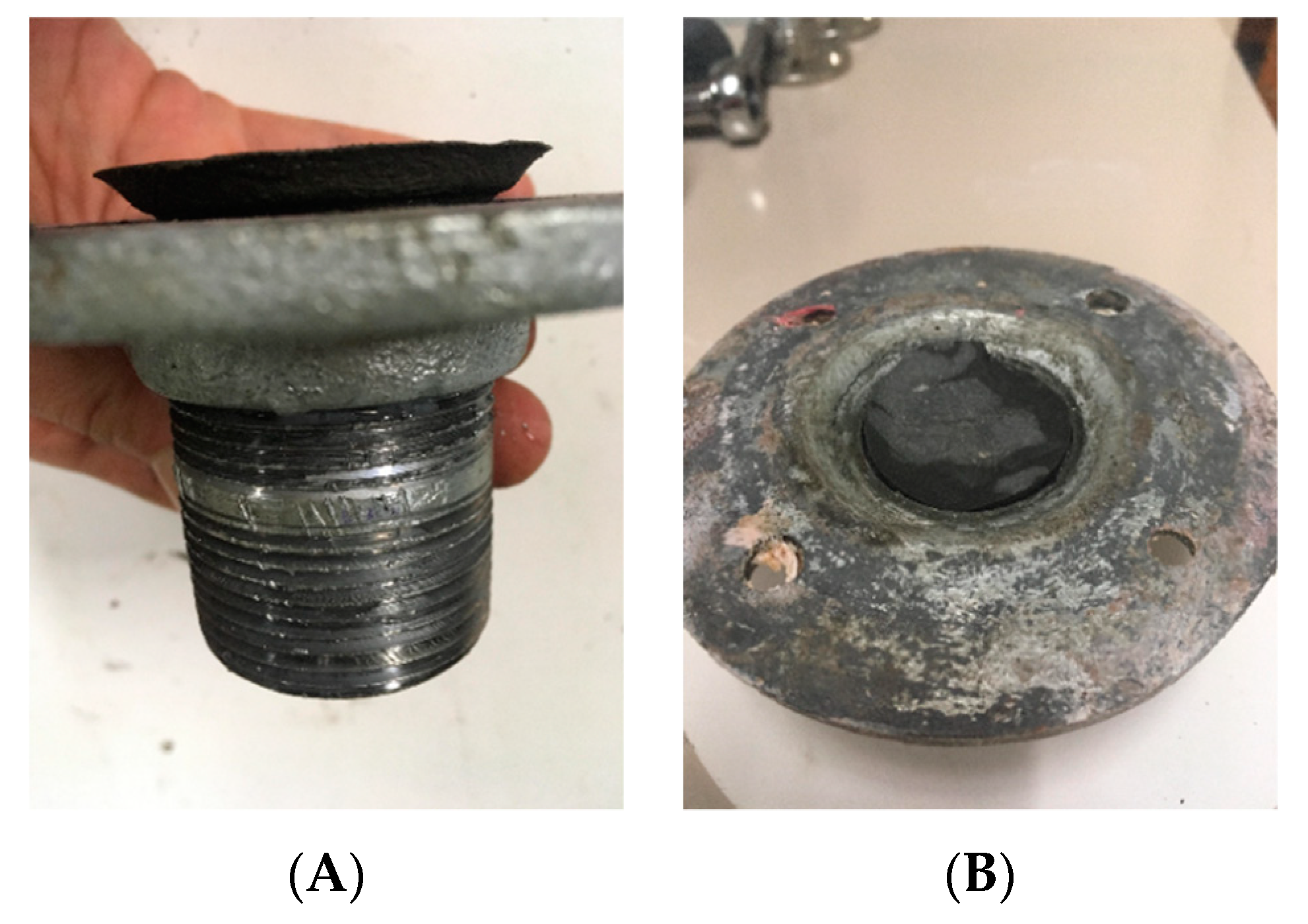
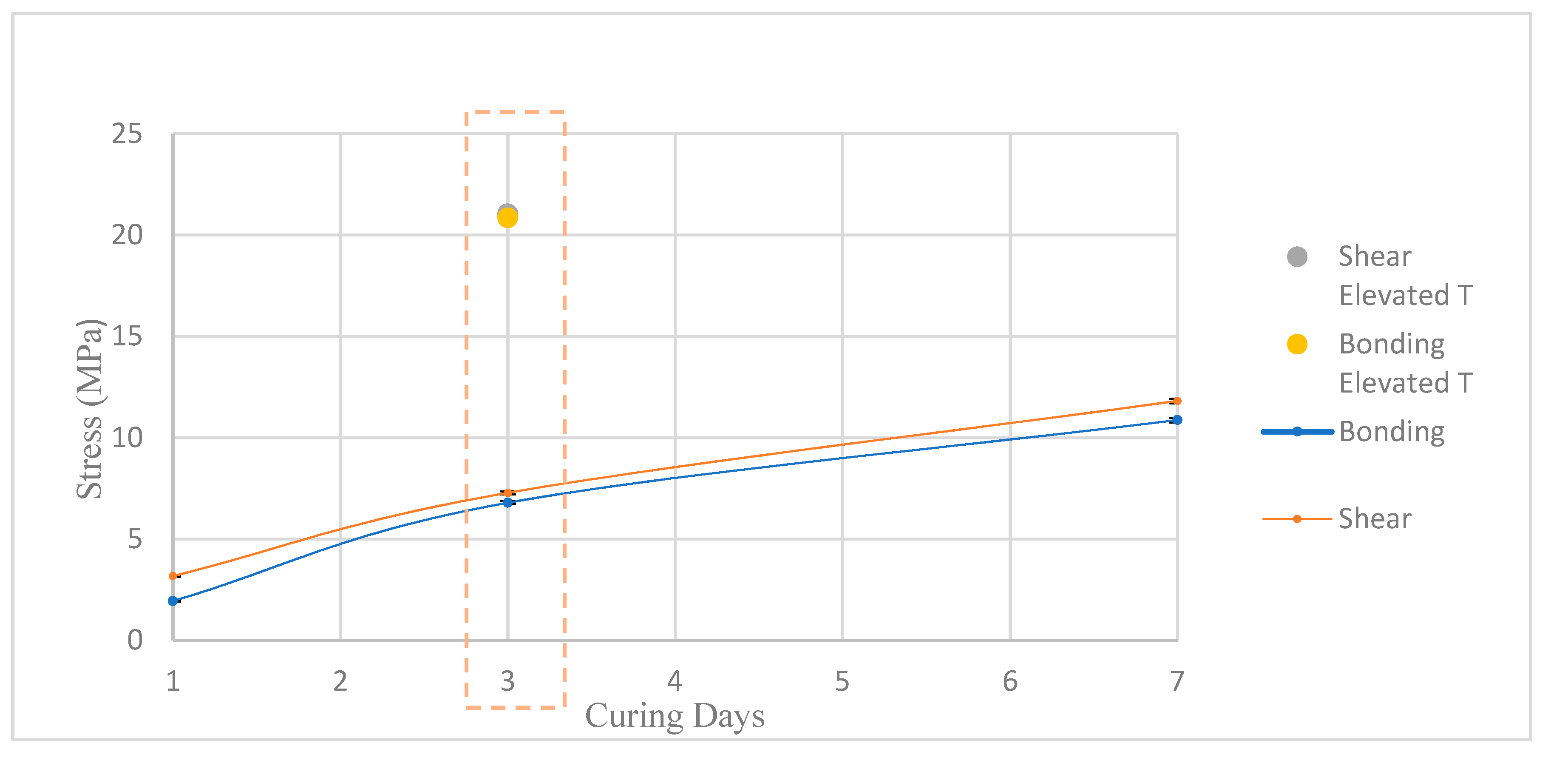

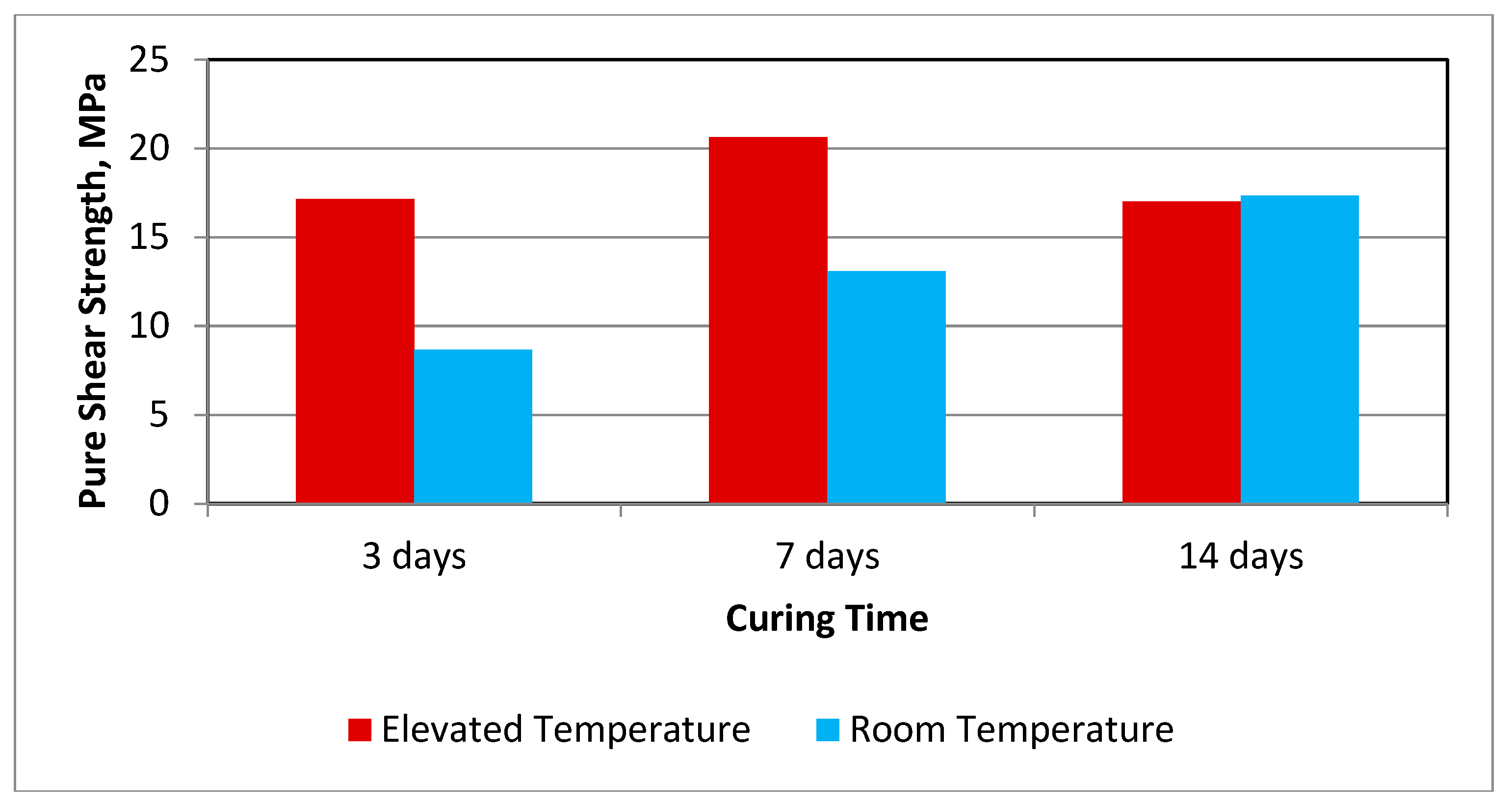
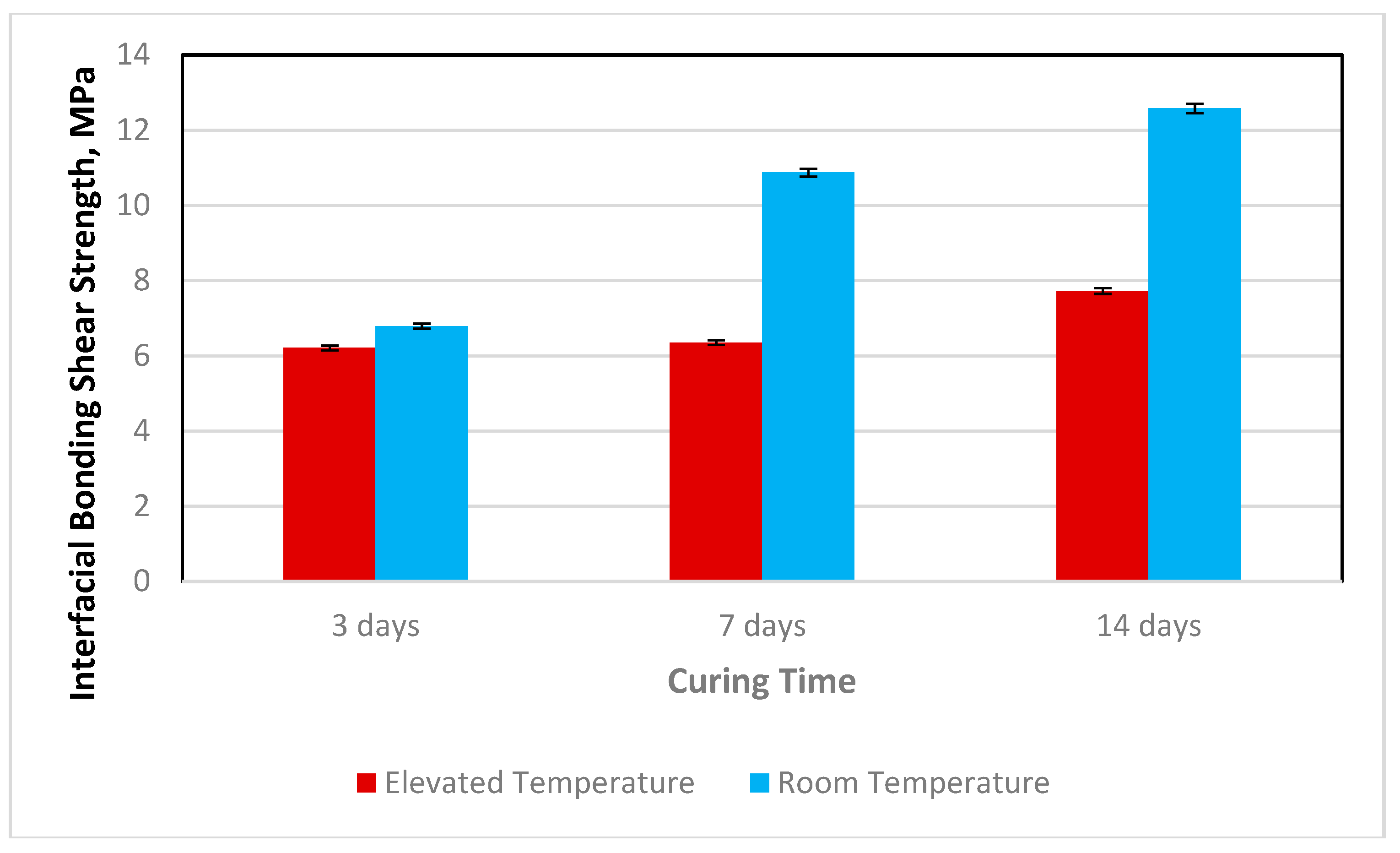
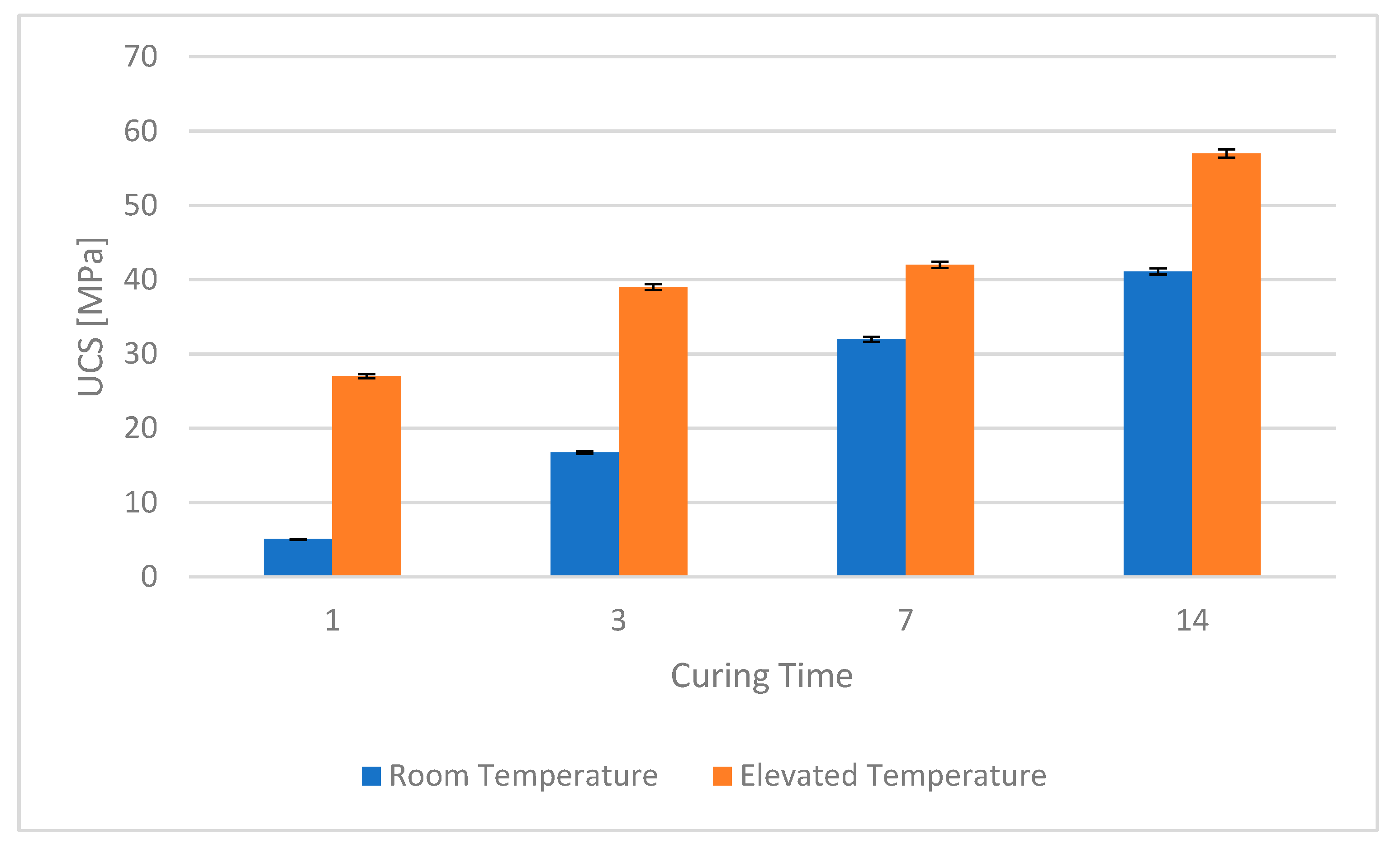

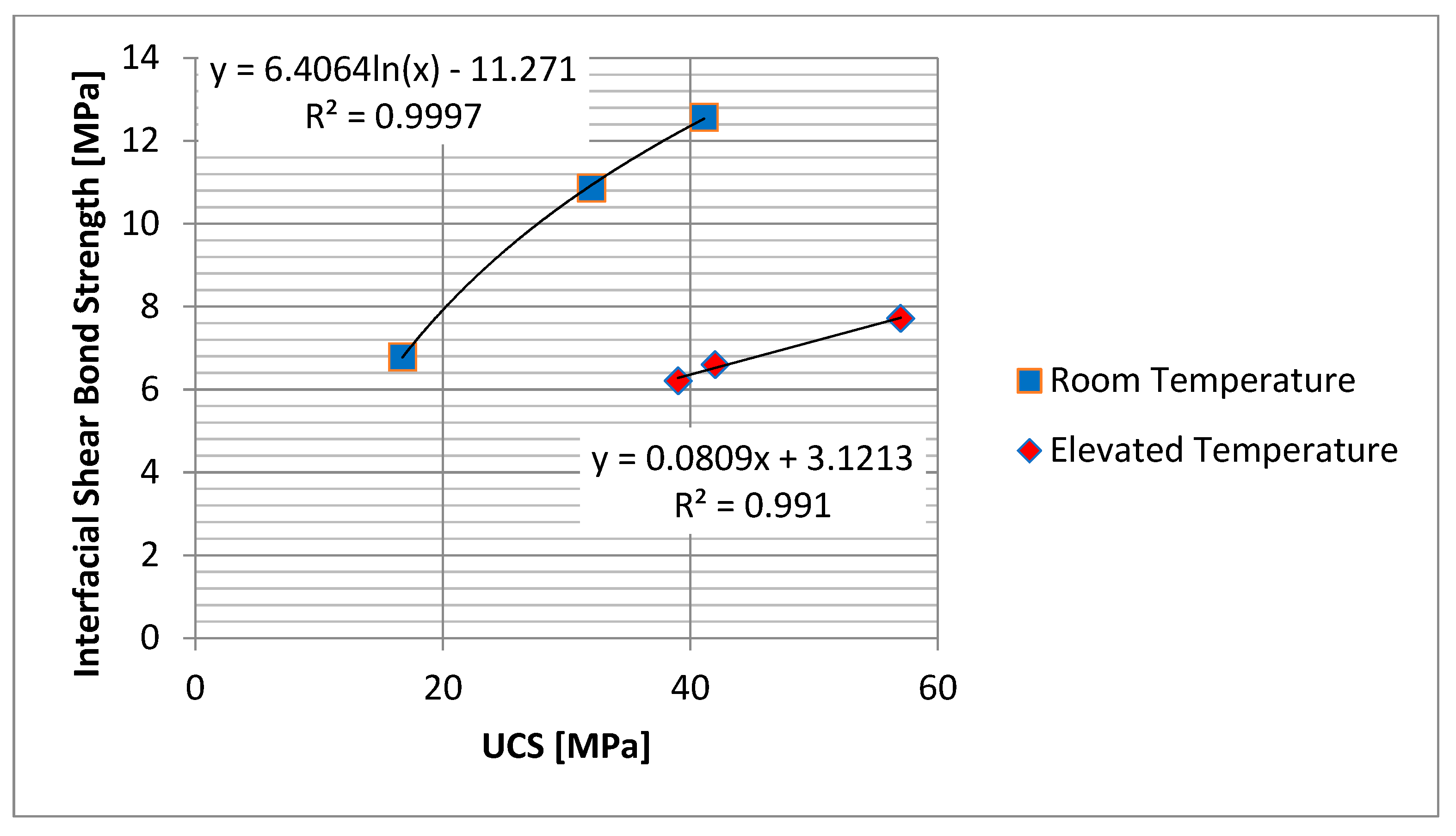
| Class | Depth (ft) | Temperature F | Purpose |
|---|---|---|---|
| A | 0–6000 | 80–170 | Used when no special needs are required |
| B | 0–6000 | 80–170 | Used for conditions requiring moderate to high sulfate resistance |
| C | 0–6000 | 80–170 | Used for conditions requiring high early strength |
| D | 6000–10,000 | 170–290 | Used where high temperatures and pressure are found |
| G | 0–8000 | - | Used with accelerators and retarders to cover all range of well depth and temperatures |
| H | 0–8000 | - | Used with accelerators and retarders to cover all range of well depth and temperatures |
| Item | Cell Length (mm) | Outer Diameter (mm) | Inner Diameter (IDA) (mm) | Inner Diameter (IDB) (mm) |
|---|---|---|---|---|
| Shear Cell | 49.2 | 75.6 | 61 | 54 |
| Bonding Cell | 50 | 40 | 35.1 | - |
| Author | Salehi et al. 2016 | Lavrov and Torsaer 2016 | Zhao et al. 2015 | Zhao et al. 2015 | This Work | This Work |
|---|---|---|---|---|---|---|
| Comment | After 24 h | - | After 5 days mixed temp. | Added sand to casing | After 24 h | After 82 days |
| Interfacial Bonding Shear Strength (PSI) | 81 | 14.5 to 145 | 14.5 to 362 | 362 to 1090 | 68 | 1450 |
| Interfacial Bonding Shear Strength (MPa) | 0.56 | 0.1 to 1.0 | 1.0 to 2.5 | 2.5 to 7.5 | 0.47–1.94 | 10 |
| Bonding Strenght (MPa) | 1st Attempt | 2nd Attempt | 3rd Attempt | Average | |||
|---|---|---|---|---|---|---|---|
| #1 | #2 | #1 | #2 | #1 | #2 | ||
| 3 day | 4.44 | 6.47 | 6.46 | 7.66 | 6.65 | 9.09 | 6.79 |
| 3 day ET | 19.52 | 18.42 | 20.54 | 24.88 | - | - | 20.84 |
© 2019 by the authors. Licensee MDPI, Basel, Switzerland. This article is an open access article distributed under the terms and conditions of the Creative Commons Attribution (CC BY) license (http://creativecommons.org/licenses/by/4.0/).
Share and Cite
Teodoriu, C.; Yi, M.C.; Salehi, S. A Novel Experimental Investigation of Cement Mechanical Properties with Application to Geothermal Wells. Energies 2019, 12, 3426. https://doi.org/10.3390/en12183426
Teodoriu C, Yi MC, Salehi S. A Novel Experimental Investigation of Cement Mechanical Properties with Application to Geothermal Wells. Energies. 2019; 12(18):3426. https://doi.org/10.3390/en12183426
Chicago/Turabian StyleTeodoriu, Catalin, Mi Chin Yi, and Saeed Salehi. 2019. "A Novel Experimental Investigation of Cement Mechanical Properties with Application to Geothermal Wells" Energies 12, no. 18: 3426. https://doi.org/10.3390/en12183426
APA StyleTeodoriu, C., Yi, M. C., & Salehi, S. (2019). A Novel Experimental Investigation of Cement Mechanical Properties with Application to Geothermal Wells. Energies, 12(18), 3426. https://doi.org/10.3390/en12183426





